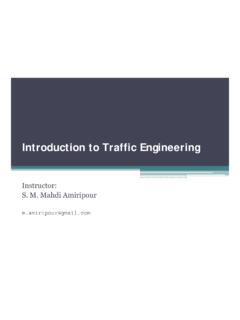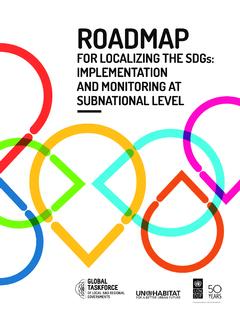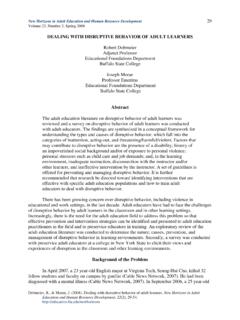Transcription of WHAT IS– – Performance Art - Irish Museum of Modern Art
1 Royal Hospital, Military Rd,Kilmainham, Dublin 8 IrelandT. 00 353 1 612 9900F. 00 353 1 612 9999E. and Community Programmes, Irish Museum of Modern Art, IMMAWHAT IS ? Performance Art There is a growing interest in contemporary art yet the ideas and theoretical frameworks which inform its practice can be complex and difficult to access. The What is_? programme, which is intended for a general audience, aims to provide an introduction to some of the key concepts and themes in Modern and contemporary art and also to provide information about the materials and methodologies employed by artists in the creation of their work. 03 THE WHAT IS ? IMMA Talks SeriesImage: GILBERT & GEORGE, Smoke Rising, What is __? talks series page 03 Introduction: Performance Art page 04 What Performance Art? - Amanda Coogan page 09 Bibliography and Further Reading page 22 Glossary of Terms page 23 Performance Art Resources page 28 This programme acknowledges the inherent problems and contradictions in attempting to outline or summarise a wide-ranging, constantly changing and contested sphere of art theory and practice and also the limitations of employing summary terms to describe a range of practice, much of which emerged in opposition to such totalising tendencies.
2 Taking these challenges into account, the intention of this programme is to promote information sharing and to encourage critical thinking, debate and discussion about art and artists. Drawing on expertise and experience from lecturers, artists, curators and critical writers, the series offers a range of perspectives and is neither definitive nor exhaustive. Each topic is addressed by a talk and supported by an information booklet which includes a summary, the presenter s essay, a reading list, a glossary of terms and a resources list. This information can also be found on IMMA s website along with more detailed information about artwork and artists featured in IMMA s Collection at IS ? Performance ArtIntroductionWhat is Performance Art?The Irish Museum of Modern Art is the national cultural institution for the collection and presentation of Modern and Contemporary Art. IMMA exhibits and collects Modern and Contemporary Art by established and emerging Irish and international artists.
3 The Temporary Exhibitions Programme features work by established and emerging artists, and includes work ranging from painting, sculpture, installation, photography, video and Performance . IMMA originates many of its exhibitions but also works closely with a network of international museums and galleries. IMMA s Collection includes artworks spanning a range of media and genres, acquired through purchase, donations, loans and commissions, many in association with IMMA s Temporary Exhibitions Programme and, on occasion, IMMA s Artists Residency Programme. This introductory text provides a brief overview of the context in which Performance Art has evolved as a form of contemporary arts practice. Terms associated with Performance Art are indicated in CAPITALS and are elaborated on in the glossary on We invited Amanda Coogan, artist and researcher, to write an essay on Performance Art entitled What is Performance Art?, which makes reference to artists and artworks in IMMA s Collection as a means of describing and contextualising this area of contemporary arts practice.
4 We hope to draw attention to the body of artworks in IMMA s Collection by artists associated with Performance Art, such as Marina Abramovi , Nigel Rolfe, Dennis Oppenheim and Gilbert & George. We also hope to draw attention to the potential of IMMA and its Collection as a growing resource for further exploration and consideration of this ART is a form of arts practice that involves a person or persons undertaking an action or actions within a particular timeframe in a particular space or location for an audience. Central to the process and execution of Performance Art is the live presence of the artist and the real actions of his/her body, to create and present an ephemeral art experience to an audience. A defining characteristic of Performance Art is the body, considered the primary MEDIUM and conceptual material on which Performance Art is based. Other key components are time, space and the relationship between performer and audience.
5 Primarily an INTERDISCIPLINARY practice, Performance Art can employ any material or medium across any discipline, including MUSIC, DANCE, LITERATURE, POETRY, ARCHITECTURE, FASHION, DESIGN and FILM. While Performance Art employs strategies such as RECITATION and IMPROVISATION associated with Image: Brian Duggan Door, and DRAMA, it rarely employs plot or NARRATIVE. Performance Art can be spontaneous, one-off, durational, improvised or rehearsed and performed with or without scripts. Performances can range from a series of small-scale intimate gestures to public rallies, spectacles or parades presented in solo or collaborative form . In contrast to conventional methods of theatre production, the visual artist is the performer, creator and director of the Performance . Performance Art can be situated anywhere: in ART MUSEUMS, GALLERIES and alternative art spaces or in impromptu sites, such as caf s, bars or the street, where the SITE and often unknowing audience become an integral part of the work s meaning.
6 Performance Art can trace its early influences to medieval performances by poets, minstrels, troubadours, bards and court jesters and also to the spectacles and masquerades of the RENAISSANCE. However, the origins of Performance Art are more commonly associated with the activities of early twentieth century AVANT-GARDE artists, in particular those associated with FUTURISM, CONSTRUCTIVISM, AGITPROP, DADA, SURREALISM and the BAUHAUS. Celebrating all things Modern , Futurist artists devised new forms of art and artist-led events, such as repetitive actions, lectures, manifestos, mass demonstrations, and live street TABLEAUx, to express the dynamism of Modern 0706urban life. Artists drew inspiration from all forms of Performance , including popular entertainment formats, such as the variety show, circus, cabaret and opera. Live public engagement was paramount and performances involved improvised, unpredictable and often chaotic programmes delivered by artists, poets, actors, architects, critics and painters, frequently accompanied by discussions and debates to spread and initiate new cultural ideas.
7 Other formative influences on the development of Performance Art include the socially-orientated, utilitarian ethos of Constructivism with its emphasis on audience participation; the underground theatre of Agitprop; the nihilistic, anti-art agenda of Dada with their anarchic collaborations, cabarets and performances; the experimental performances, films and theatre productions of the Surrealists and the innovations of the Bauhaus school and its influence on interdisciplinary arts education. These experimental and innovative art movements contributed to the displacement of the art object as the locus of artistic engagement and the establishment of Performance as a legitimate form of artistic expression. They also set a new precedent for interdisciplinary COLLOBORATION, where artists employed a range of art forms to create new modes of Performance and artist-led events. The influx of European artists into America in the 1930s and 40s, in particular those associated with Surrealism and the Bauhaus, contributed to the emergence of ABSTRACT ExPRESSIONISM and ACTION PAINTING as the dominant modes of artistic expression during the 1940s and 50s.
8 The development of Performance Art is associated with the photographic and film documentation of action painters. Artists perceived the action of creating the art object as a potential for Performance in itself, and reinterpreted this through live painting performances using the human body as a paint MULTIDISCIPLINARY events and performances known as HAPPENINGS in the late 1950s and early 60s had a significant influence on the development of Performance Art. Happenings emphasised the importance of chance in artistic creation, audience participation and the blurring of the boundary between the audience and the artwork. Similarly, the interdisciplinary approach employed by FLUxUS artists sought to blur the distinction between art and the everyday. Prompted by the social, cultural and political changes during the 1960s, artists became concerned with the increasing COMMODIFICATION of art and the relationship of the art institution to broader socio-economic and political processes.
9 Informed by new developments across a range of theoretical and practical disciplines, such as FEMINISM, POSTCOLONIALISM and CRITICAL THEORY, and drawing on earlier strategies of disruption, artists devised new forms of practice, such as temporary, TExT-BASED, DIDACTIC and performative work, to complicate the perception of the art object as the 1970s the term Performance Art had come into general usage and was closely associated with CONCEPTUAL ART, which emphasised the production of ideas over art objects. The ephemeral, corporeal and radical potential of Performance Art appealed to artists committed to destabilising the material status of the art object. The potential for Performance Art to bypass the Museum or gallery and mediate directly with the public instigated a surge of ARTIST-LED INITIATIVES and alternative spaces in which experimentations in Performance could be devised. Performance Art employed many of the tendencies of SITE-SPECIFIC ART and INSTITUTIONAL CRITIQUE in its consideration of space, context, site and intervention.
10 The proliferation of Performance Art in the 1970s resulted in the emergence of new forms and categories of Performance Art. Prompted by the political and social upheaval of the 1960s, activist-based performances, such as ACTIVIST ART, STREET ART and GUERRILLA THEATRE, sought to draw attention to political and social issues through satire, DIALOGICAL and protest techniques. Body-based performances were influenced by the emergence of feminist theory and critique in the 1960s and 70s which re-evaluated traditional representations of the female body. Artists used their bodies to challenge restrictive definitions of sexuality, actively exhibiting their own naked bodies to undermine conventional notions of female nudity. Similarly, artists used their bodies to test the limits of the performing body, pursuing themes of endurance, self-control, transformation, risk and pain. The body was interpreted as a universal READYMADE which gave rise to offshoots of Performance Art, such as BODY ART, FEMINIST ART and LIVING SCULPTURE.







